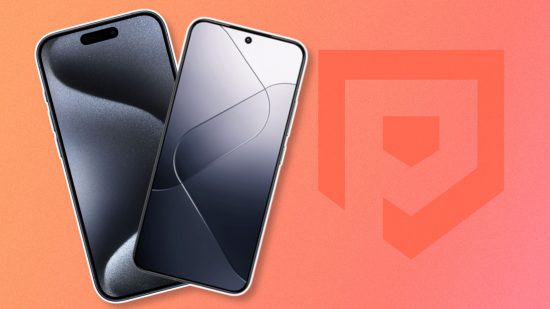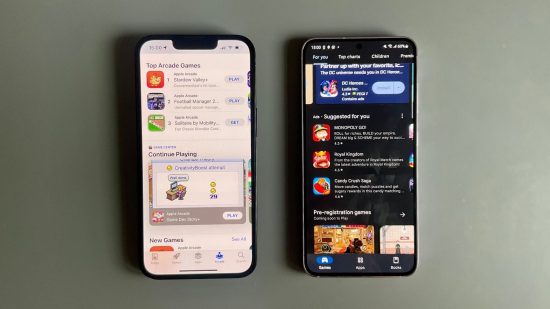Of all the battles in the smartphone arena, this one is the biggest bout. iPhone vs. Android: which is better? Of course, it’s a very complicated question to try and answer, with subjective opinion playing a massive part in which you might opt for when it comes time to get a new handset. Still, it’s a question that needs answering, so we’re going to give it a go.
At Pocket Tactics, we’ve amassed hundreds of hours testing out the latest iPhone and Android devices, so, we’re well prepared to help you discover the best handset for your needs. If you’re more interested in a direct head-to-head, see our Samsung Galaxy S24 Ultra vs. iPhone 15 Pro Max guide to figure out which is the best flagship for 2024.
Why you can trust our advice ✔ At Pocket Tactics, our experts spend days testing games, phones, tech, and services. We always share honest opinions to help you buy the best. Find out how we test.
iPhone vs. Android: which is better?
There are many different categories in which we can compare iPhone vs. Android, so if there’s a specific aspect you’re interested in, you can find it below.
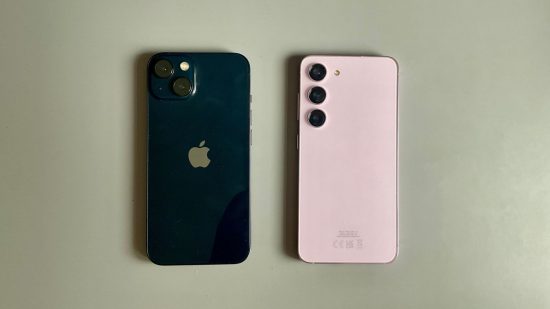
Hardware
Whether you love loving at a specs table or not, there’s no escaping the fact that a great smartphone requires top-end hardware. Apple and all the big Android brands are incredibly aware of this, but every brand has a slightly different approach to what hardware it includes in its flagship, mid-range, and budget phones. So, let’s explore the role hardware plays in the iPhone vs. Android debate.
Flagships
In terms of the high-end flagships available in 2024, there’s very little to separate the Apple and Android devices in terms of performance power, displays, and storage. Whether you’re picking up the most expensive iPhone, or the Samsung, Xiaomi, or OnePlus equivalent, you’re getting a device well-equipped for both day-to-day use and intense gaming.
From Apple, there’s the choice of two flagship handsets: the iPhone 15 Pro and the 15 Pro Max. These smartphones offer the latest technology at the brand’s disposal, in terms of cameras, chipset, and display. Put simply, there’s no better Apple device you can get your hands on until the iPhone 16 arrives.
From Android, Samsung is the clear leader, though there are more options than Apple. There’s the Samsung Galaxy S24 Ultra, the best flagship Android in our opinion. However, if you fancy something different, there’s the Oppo Find X7 Ultra, the Honor Magic6 Pro, and the Xiaomi 14 Ultra, too. All of these are pretty exciting options.
The Pro range of the latest iPhones utilizes Apple’s A17 Pro chip, the most powerful chip from the brand to date. In terms of performance, it beats the top-end Android chip in most benchmarks, though that’s not the most important thing – the top-end iPhones have more than enough power for the most demanding users, and that’s all that matters.
This also applies to Android, however, with the Samsung S24 Ultra offering excellent power for all your needs by utilizing a state-of-the-art Snapdragon 8 Gen 3 chipset, as well as competitive power efficiency and ray-tracing. While one may be better than the other on paper, the difference between the top-end Android and iPhone chips is nominal. In everyday use, neither misses a beat.
Then, there’s the ASUS ROG Phone 8 Pro. While we’ve struggled to recommend past generations of ROG Phones due to how gamer-orientated they are, the latest from the PC gaming brand is still an excellent choice for those who spend hours playing mobile games but also for general Android users. The cameras are better, the design is sleeker and much more discrete, and the 165Hz LTPO AMOLED display is second to none. If you want to know more about this one, check out our ASUS ROG Phone 8 Pro Edition review.
Finally, on the high-end, it’s all about cameras. And this is where things get a little trickier. The new Xiaomi 14 Ultra arguably has the best cameras you can get in a smartphone, though the upper-mid-range Google Pixel 8 Pro could also be considered best – and it’s hundreds of dollars cheaper. Both also have some incredible AI picture editing features that don’t require anything near the same level of technical proficiency as something like Photoshop. There’s also the Samsung Galaxy S24 Ultra and Honor Magic6 Pro, which both offer some powerful technology for amateur smartphone photographers.
Meanwhile, the iPhone 15 Pro Max is the best phone for video, and the OnePlus 12’s camera is no slouch either. If all you want is a great camera, it might be worth looking at our Google Pixel 8 Pro review and saving yourself some money, though the flagships are also excellent snappers.
The last big differentiator in terms of flagships is in the foldable arena. There are no foldable Apple phones, though some insider reporting suggests we might get one in the next few years. However, there are plenty of foldable Androids, including the Samsung Z Fold5, the OnePlus Open, and more. The Samsung is arguably the best of the bunch, but they’re all pretty impressive.

Mid-range
Things get a little trickier when differentiating between devices in the mid-range market when it comes to the iPhone vs. Samsung debate, and this isn’t helped by the wide price range. At the upper edge of the price range (around $800), there’s the Google Pixel 8 Pro, iPhone 15, and Samsung S24 (the latter two come in plus sizes as well). These aren’t quite flagships, though they’re pushing the definition of mid-range.
At this higher price point, the Google Pixel 8 Pro offers the best cameras, the Samsung S24 is a great all-rounder, and the iPhone 15 offers great integration into Apple’s ecosystem and a stellar chipset, too. All in all, there aren’t many key differences between the bunch, so choosing between them is down to the further comparisons below.
The proper mid-range phones on the market are where things get a bit more interesting. Here, phones cost between $350 and $600, and there are some real bargains available from a wide variety of manufacturers. The Honor 200 Pro is our pick of the bunch for 2024 so far, with excellent features for its low price, while Samsung’s A54, Nothing Phone (2), and the Redmi Note 12 Pro offer great value from reliable brands.
From Apple, there’s only one mid-range handset: the iPhone SE. It still has the same old design as the iPhone 8 (a phone from 2017), though its innards are updated to keep its performance competitive. As we’ve not had a new iPhone SE since 2022, it’s a little behind the times, but it looks like we’re getting the fourth generation of SE in 2025, so that’s definitely one to look out for.
From Apple, the most recent mid-ranger is still the 2022 iPhone SE. Despite it only being a couple of years old, it’s nowhere near the performance levels you can get from the Honor and Samsung alternatives. However, if you prefer the iOS feel and don’t delve into demanding mobile games like Diablo Immortal, Honkai Star Rail, and others, the SE is a decent phone, it’s just not as impressive as the Android mid-range competitors.
Budget
As has been the case since the dawn of the iPhone, Apple doesn’t really do budget devices. The only options in this price range are second-hand devices, with refurbished versions of the iPhone 13 and 14, as well as the 2022 iPhone SE, all floating around the $300 mark. Even still, this is on the more expensive side of the budget spectrum, with plenty of Androids available for less than $200.
So, let’s take a look at some of those affordable Androids. Xiaomi has two budget subbrands, with the Redmi Note 11 offering excellent all-around performance for its low price. Meanwhile, as you can see in our Poco X6 Pro review, Xiaomi’s gaming subbrand sure offers bang for your buck.
Meanwhile, TECNO – a very popular brand in emerging markets – offers some very impressive budget handsets. Our TECNO CAMON 20 Premier 5G review may not be a full-on love story, but the phone is a solid all-rounder. Meanwhile, our TECNO POVA 6 Pro 5G review has all the details for anyone hunting for a budget gaming phone.
Of course, there are excellent budget options from the bigger brands too, and these may offer better security updates and longer-term support, as we go into more detail about below. The Galaxy A series offers a wide range of phones at different price points to fit your budget, with Samsung trustworthiness tied in, while the Pixel 6a is still available from Google at a discounted price which makes it a really tempting choice.
So, there’s clearly a very wide range of phones to choose from, whether you want to spend $100 or $1,000. While the hardware is often the focus for any prospective buyers, there are some key differences between iPhone and Android beyond what’s on the surface. So, let’s get stuck in.
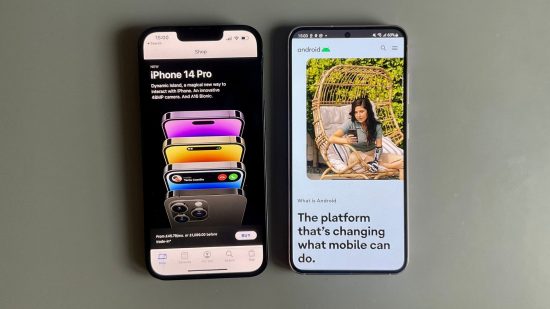
Operating system
Choosing between Android and iOS is the biggest difference between the two competitors, though it’s not as grand a divide as you may think. There are some key differences, but fundamentally, both iPhone and Android can do most of what you need, they might just do it in different ways.
iOS
What is iOS? Well, it’s Apple’s operating system for iPhones, which means it’s the way you interact with the device and the different features it offers therein. Just like Android, it offers a wide variety of built-in apps, a massive App Store to find more, and a slick interface to get things done simply.
There are some key differences, however. First off, iOS is the same across all iPhones. No matter which handset you pick up, you have the same version of iOS (assuming it’s new enough to receive the latest updates). This is helpful if you’re used to iOS, or you want a consistent OS as you upgrade phones over the years.
iOS also doesn’t come with any random stuff pre-installed, a.k.a. bloatware. Not all Android phones do this – most of the big brands ask first before adding any junk – but Apple never does anything like this with its iPhones, which is nice. This is again a bonus for simplicity, meaning you only have exactly what you need.
Android
Android is the operating system used by Samsung, Google, and countless other phone manufacturers. While the operating system can differ between different companies – the different versions are called “skins”, sort of like an overlay on top of the base Android OS – there are still lots of similarities across Android phones.
The biggest benefit to using Android is how much easier it is to customize your phone compared to an iPhone. Android doesn’t have Apple’s walled garden, so you can use different app stores, install ROMs and emulators, and access plenty of third-party systems to enhance your experience. However, some of this can get a bit technical, so if you prefer an easy system where less is likely to go wrong, you might be better off with the iPhone.
But, while the operating systems offer different types of customization and accessibility, another key area to focus on is the features these systems have. This is where things get a bit more variable across different brands, so the decision might become a tad easier.
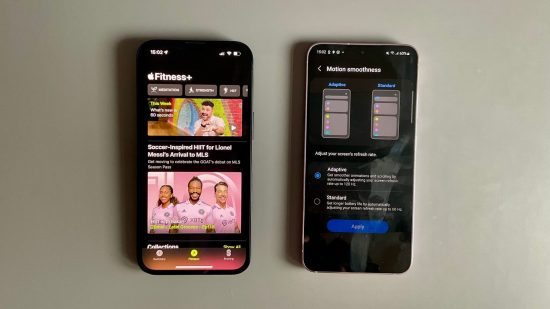
Key features
There are various features offered across iPhone and Android, many of which are available on both. Here, we break down key features unique to specific smartphones, so you can see what can only be done and where to do it.
Apple
iOS offers many features that you can get nowhere else. iMessage, the blue-bubbled messaging service only works between iOS devices, while FaceTime only recently allowed non-Apple devices to join a call, though it’s not integrated as smoothly as on Apple devices, of course. Then there are features like SharePlay, which lets you watch a film or listen to music with a friend while on a call, that, while niche, are also only available on Apple devices.
Meanwhile, the ecosystem integration with Apple is unmatched at the time of writing. You can copy something on your phone and paste it onto a Mac or iPad seamlessly, use your iPhone as a webcam or microphone, and set up new devices from your old devices easily. There are a bunch of other features like this, all of which make using an Apple Watch, Mac, or HomePod far easier. If you want any of those devices or already own them, we highly recommend going for an iPhone.
Android
Android also offers features that Apple doesn’t. You can set up multiple users on a device if you’re sharing it with family or have different needs for work and leisure, which is super helpful (especially on a tablet!). Then there’s the added customizability as we mentioned earlier, letting you change all manner of settings for a bespoke experience.
The other big benefit of Android is that it’s open – you can download specific ROMs or APKs, which are basically install files, rather than going through an app store. This comes with its own risks, sure, but if you want the latest software for a phone left behind by the manufacturer, an old PS1 game, or all manner of other unique apps, Android is the best way to go (assuming you’re techy enough to do it safely; never download from unknown sources unless you know they’re safe).
Gaming
Now more than ever, gaming is a massive part of the mobile experience and a significant factor in the iPhone vs. Android argument. Of course, the variety of Android phones means there are more gaming-specific devices, but Apple’s unique services and cross-device integration means it’s still a contested field.
Apple
The main bonus to getting an iPhone for gaming is Apple Arcade, the company’s subscription service with a pile of excellent mobile games. There’s Google’s Play Pass on Android, but in terms of the quality of the games on the service, it can’t really match Apple.
Apple Arcade also has exclusive games, so if there’s something that’s caught your eye, make sure it’s not an iOS exclusive. We’ve got a list of the best Apple Arcade games so you can see what’s on the service, but for our money, it’s the best mobile gaming service available at the moment.
As of 2024, you can also download emulators on iPhone, which is a major boon for Apple, even if it resisted allowing emulation on the software for years. It’s a bit trickier to customize your emulation experience, but if you’re happy with the basics, it’s another bow in the iPhone’s quiver.
Apple also has great integration across all its devices. You can start playing something on your iPhone, pick back up on Mac, hop on the sofa and play it on your Apple TV, or lounge around with it on your iPad, with all your saves transferred over. What’s more, you can do this all with a Nintendo, Xbox, or PlayStation controller without any hassle connecting them up. Lovely.
Android
Like Apple, Android has its own gaming subscription service in the form of the Google Play Pass. While this library of games is much larger than Apple Arcade, the quality of the titles included is also much more varied than the iOS alternative. It’s not awful, but it’s worth checking out the list of games on the service before parting with the subscription fee.
Where Android is the clear winner, however, is with gaming-specific hardware. Whether it’s the best gaming phones from ASUS or Redmagic, Android is the only place you can get phones specifically designed to be excellent at playing mobile games. If you want a phone like that, you know where to go.
Emulation is also much easier on Android, even if it’s now technically possible on iPhone. With Android, you can drag and drop files from your PC, so you can easily move over any roms you’ve made to play on the go

Security
Security varies from brand to brand, and while Android has built-in security features, different manufacturers have different safeguards on top of it, making the Android side quite hard to parse. Companies like Samsung and Google have top-notch features to aid security, and many promise at least three years of software and security updates to keep you secure as your device gets old.
However, not every Android brand offers devices as secure as Area 51. It’s important to do a bit of due diligence before going for one of the lesser-known brands to make sure you’re covered with security updates for at least a couple of years unless you routinely switch out your device of choice.
When it comes to Apple devices, you don’t need to do your research. iPhones have always been incredibly reliable when it comes to security, and it’s one of the things that has made the smartphone such a popular choice among consumers. We don’t see that changing anytime soon.
Apple has recently started pushing rapid security response updates, too, which are quick fixes to minor issues. While we would never say you’re 100% secure using any device, Apple is our go-to – though Samsung also has a focus on security that shouldn’t be ignored, too.

Repairability
Repairing an iPhone has always been complicated, with Apple rarely sharing details on how to fix problems with its devices. The old adage ‘if you want something done properly, do it yourself’ does not apply here. If you have a problem with your iPhone, you’re going to have to make a trip to your local Apple Store to visit the Geniuses. Or, you can take your chances with an independent vendor, but it is a bit riskier than the official route and may void any warranty.
Meanwhile, many Android manufacturers pride themselves on their repairability. Nokia is a leader in this regard, with excellent tools to help you keep your phone running for longer with your own two hands, helping you stay green and keep your costs down while staying in the smartphone market. As always, repairability differs greatly across the Android market, so be sure to look into an individual handset before purchasing if repairability matters a lot to you.
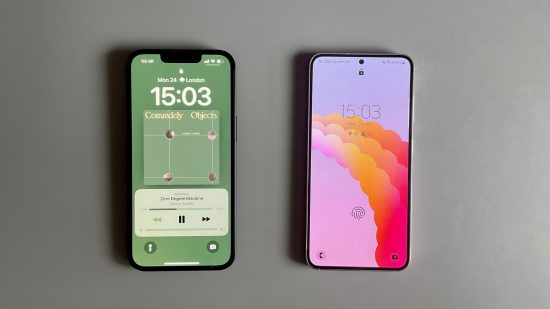
iPhone vs. Android: which one should you choose?
Choosing between iPhone and Android is tough, though it becomes a lot easier once you know exactly what you need. If you want to keep things simple while using your phone and don’t need a super-budget handset, Apple is likely the best way to go. Meanwhile, if you have specific hardware needs not catered to by Apple, or fancy tinkering a bit with your phone by adding unique software and customizing the experience, that’s what Android can do for you.
Any casual user can expect an excellent experience from both sides of the tech coin – if you’re not going to delve deep into either, you’ll likely not see the many benefits and drawbacks that lie beneath. So, if you just need a phone for basic phone things, find a handset that looks nice at a good price and you should be happy with either Android or iOS.
For an easy metaphor, Apple’s iOS is like the most luxurious kindergarten you’ve ever been to – everything is super simple, easy, and really quite lovely, though there’s padding on all the table corners so you don’t hurt yourself; your freedom is limited. Meanwhile, Android is like going to university for the first time; it’s somewhere you can make dozens of different mistakes as you try and work your way through it all. But there’s also power in that independence. For me, I’m sticking to pre-school safety in iOS, but that’s not exactly adventurous, is it?
Read our how we test page to find out more about how we research the phones discussed in this article. Of course, choosing Android or iOS is only half the process of choosing a phone – read our guide on the best cell phone providers guide to help you pick the right service for you. If you know you want something durable, read our list of the best rugged smartphones too.
